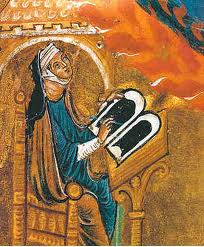Hildegard of Bingen, We Need You!
By Dr. Scott Lively
As LGBT History Month draws to a close it is ironic that one of the fiercest “homophobes” of all time is being honored this week with the post-humus publication of some of her musical compositions in an album predicted by industry experts to top the charts. The woman is Hildegard of Bingen, a twelfth century Benedictine abbess who was canonized earlier this month by Pope Benedict. WND linked to the story here: http://www.wnd.com/2012/10/medieval-nuns-800-year-old-chants-top-charts/?cat_orig=faith. What these music industry experts (and the producer whose best known work is for Madonna and Brittney Spears) probably don’t realize is that Hildegard devoted a substantial portion of her life in the1100’s to vigorously opposing homosexuality.
By coincidence I happen to be working on revisions and additions to Chapter Two of my book The Pink Swastika as my co-author Kevin Abrams and I prepare the 5th edition for publication. New in the 5th edition is a section featuring Hildegard’s efforts to stop a homosexual gnostic cult called Manichaeism from infiltrating the Catholic Church.
Allow me to simply excerpt the relevant text from Chapter Two, titled “Homo-Occultism:”
“Arthur Evans’ Witchcraft and the Gay Counterculture provides some illumination here. Mani, for whom Manichaeism is named, was a third century Prince of Babylon who devised his own form of Gnosticism. Gnostics blended pagan sex rituals and Mother Goddess worship with elements of New Testament Christianity and “rejected Jehovah God as an evil demon.”[i]
“Manichaeism imposed on Gnosticism a caste system of leaders (elect) and followers (hearers). A Manichaean sect called the Bogomils (later called the Cathars) arose in Bulgaria and spread across Europe. Homosexuality became so closely associated with these Bulgarian heretics that the practice became known as “buggery.” Indeed, “the word for Cathar in most European languages came to be the word for homosexual: in German, Ketzer, in Italian, Gazarro, and in French, Herite….Heresy and homosexuality became so interchangeable that those accused of heresy attempted to prove their innocence by claiming heterosexuality” (Evans:51ff).
“Just what did the Cathari believe and preach? Historian Thomas Merton describes their theology:
The very core of the Catharist’s spiritual life was a morbid horror of sex and of the flesh….Since the flesh was evil, and bodily life was an almost irreparable disaster, the Cathari naturally concluded that marriage was a device of the devil…[for] encouraging the procreation of children and the imprisonment of more souls in the flesh. Therefore they taught that no man who persisted in matrimony until death could be saved. The effects produced by this teaching…[was] an almost total disregard for sexual morality and in the complete disruption of family life…[T]here was no such thing as responsibility for the sins of the flesh: such “sins” were simply the work of the devil. The flesh was entirely under his power…Man was not free to resist. Finally [and very significant in light of Adolf Hitler‘s choice to be a “vegan”]…came the asceticism of the so-called “perfect.” They would not eat meat or eggs or drink milk on the grounds that these things were defiled by animal generation (Merton: p.37-38).[ii] [Hitler was strongly influenced by Manichaeism.]
“In The Nazis and the Occult, author Dusty Sklar reports that Cathari Gnosticism was also a primary root of Nazi anti-Semitism, fostered in Germany by the founder of Theosophy, Helena Blavatsky Sklar writes:
A famous medieval Gnostic sect, the Cathars, came to identify the Old Testament god Jehovah, with the demiurge [an inferior deity], the creator of the material world, and therefore the equivalent of Satan. Within Gnosticism, then, exited the idea that the Jewish god was really the devil, responsible for all the evil in the world. Without intending to arouse hatred against the Jews, H.P.B. repeated the Gnostic thinking in her book The Secret Doctrine” (p.12).[iii]
“Sklar adds that the formation of Blavatsky’s Theosophical Society is considered by many the beginning of modern occultism (ibid: p.11). But as King Solomon wrote, “There is nothing new under the sun” (Ecclesiastes 1:9).
“A witness to this from the twelfth century is the legendary German philosopher, writer and composer Hildegard of Bingen, considered a saint by the Catholic church. Much of her work as a Christian reformer centered on exposing and opposing the influence of the Cathars on the medieval church, which, in addition to converting otherwise normal men into Sodomites, fostered widespread cultural misogyny (hatred and distrust of women) as was also true of occultists in Nazi and pre-Nazi Germany.
“In a commentary applying the teachings of the Book of Revelation to her own time Hildegard wrote:
[D]iabolical seduction [by the Cathars] gives rise to criminals and seducers, the hate and the crime of the devil, brigands and thieves; but it is in homosexuality that the sin is most impure, the root of all vices. When these sins have accumulated among the nations [she adds prophetically], the constitution of God’s law will be torn, and the Church, like a widow, will be stricken (Pernoud: p.107).[iv] (Emphasis ours.)
“Sounding just like a modern Judeo-Christian social activist, Schipperges writes that “Hildegard felt that she had to make public appearances and to take an open stand” to “preach against the Cathar sect” and restore the biblical perspective of sexuality that men and women are created to be “one flesh in loving union” (pp.59, 78).[v] “
While the modern homosexual movement differs in many ways from its twelfth century Cathari ancestor, the similarities are striking, as is the simple fact that homosexual activists then and now seem determined to infiltrate and corrupt the Christian church.
Oh Hildegard, we could certainly use your boldness in our century! But somehow I don’t think you’d be lauded by our music industry if you were here.
[i] Evans, Arthur. Witchcraft and the Gay Counterculture. Fag Rag Books, Boston 1978.
[ii] Merton, Thomas. What Are These Wounds?: The Life of a Cistercian Mystic Saint Lutgarde of Aywieres. The Bruce Publishing Company, date?.
[iii] Sklar, Dusty. The Nazis and the Occult. New York, Dorset Press, 1989.
[iv] Pernoud, Regine, Hildegard of Bingen: Inspired Conscience of the Twelfth Century. Marlowe and Company, 1998.
[v] Schipperges, Heinrich. The World of Hildegard of Bingen: Her Life, Times, and Visions. Burns and Oates, 1998.




